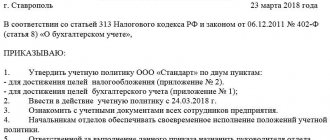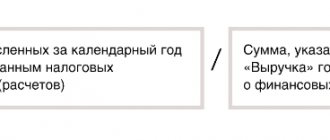FIFO in accounting is...
FIFO is one of the acceptable methods in accounting for writing off the cost of materials for production or when they are otherwise disposed of (clause 73 of the Methodological Guidelines for the accounting of inventories, approved by order of the Ministry of Finance of Russia dated December 28, 2001 No. 119n).
This material will introduce you to other methods of writing off inventories..
This method is applicable in the accounting of companies with different industry specifics:
- industrial enterprises;
- logistics companies;
- wholesale companies, etc.
For retail trade, the FIFO method is unsuitable, since it does not allow accounting to formulate the cost price for individual types of goods in an accurate estimate.
This method is based on the assumption about the order in which inventories are written off: when materials are written off for production or otherwise disposed of, they are assessed in the sequence in which they were acquired. At the same time, a strict chronology of their receipt and write-off must be observed.
If you don’t know which method to choose when writing off inventories, use the recommendations of ConsultantPlus experts. Get trial access and upgrade to the Ready Solution for free.
Because of this assumption, the FIFO method is often called the "pipeline model" or the "natural queue method." Based on the basic principle of the FIFO method (“first in, first out”), the materials that arrive first at the warehouse are used first.
FIFO and LIFO method. Advantages and disadvantages
The opposite of the FIFO accounting method is LIFO (Last In First Out) method The LIFO method is also called the barrel model, since the materials that were received last are written off first. It should be noted that the LIFO method is used for tax accounting purposes only.
The methods are also used in warehouse logistics, for example, the FIFO method is used for warehouse accounting of perishable inventories. (click to expand)
| Accounting methods | Advantages | Flaws |
| FIFO method | High calculation speed and ease of use in accounting. Used in companies in which the production process has sequential use, which is typical for perishable materials. Increasing the creditworthiness of the enterprise and the ability to attract more financing from investors and creditors when accounting for financial results using the FIFO method. | Failure to take into account inflation due to uneven use of material reserves. The cost of received materials increases by the percentage of inflation, which leads to an overestimation of the financial result and an increase in tax costs in the future. Inflated financial results when accounting using the FIFO method can lead to the choice of the wrong enterprise development strategy. |
| LIFO method | The ability to reduce tax liabilities when the volume of inventories is small, and when the volume of purchased inventories is greater than those written off. Reducing tax costs leads to an increase in the company's cash flows, which increases its financial stability and frees up additional resources for increasing its value. Better estimates the amount of economic profit when calculating the replacement cost of inventories. | Increased tax costs when accounting for inventories that are often liquidated. Lack of ability to reflect the real movement of inventories in production. |
For more information about accounting for inventories, read the article: “Accounting for receipt of materials in accounting. Postings. Examples."
FIFO Application Models
There are 2 types of FIFO method:
- standard (ordinary), which involves the calculation of incoming and consumable materials, and unused materials are taken into account once at the end of the month;
- modified (sliding), which assumes the reverse order of calculations - first, the balance of materials at a certain point in time is determined at the price of the last ones at the time of acquisition, and then the cost of inventories written off for production is calculated.
Example
A special additive is used in the production of Tekhnologiya LLC products. At the beginning of the month, the company’s accounting records the balance of the additive in the amount of 60 kg (the price of 1 kg is 245 rubles, the cost of the balance is 14,700 rubles).
Within a month, the warehouse received an additive for a total amount of 274,200 rubles:
- 1st arrival - 600 kg (254 rub./kg);
- 2nd entry - 300 kg (270 rub./kg);
- 3rd entry - 150 kg (272 rub./kg).
720 kg of additive were written off for production.
Calculation using the standard FIFO model:
1. Let's calculate the cost of the written-off additive:
- 60 kg from the balance at the beginning of the month (RUB 14,700);
- 600 kg from the 1st receipt (600 kg × 254 rub./kg = 152,400 rub.);
- 60 kg from the 2nd receipt (60 kg × 270 rub./kg = 16,200 rub.).
————————————————————
Total: 14,700 + 152,400 + 16,200 = 183,300 rubles.
2. Determine the cost and amount of remaining material at the end of the month:
14,700 + 274,200 − 183,300 = 105,600 rub.
60 + (600 + 300 + 150) − 720 = 390 kg.
Calculation using the modified FIFO model:
1. With a balance of 390 kg (240 kg from the 2nd receipt and 150 from the last), the cost of the additive remaining in the warehouse at the end of the month will be:
240 × 270 + 150 × 272 = 105,600 rub.
2. Calculation of the cost of the additive written off for production:
14,700 + 274,200 − 105,600 = 183,300 rub.
Conclusions from the considered example:
- the cost of written-off materials and balance are the same when using both FIFO models;
- with the second option, it is enough to accurately determine which materials from which batches make up the balance in the warehouse, and the cost of written-off materials is determined by calculation without necessarily being allocated to a specific batch;
- with the first option, you need to accurately determine from which batches the materials are written off and remain at the end of the month.
Thus, the standard FIFO calculation model has increased labor intensity if materials are purchased quite frequently during the month.
ConsultantPlus experts explained in detail how to account for goods in wholesale and retail trade. If you don't have access, get a free trial online access to the system.
For postings when writing off materials, see here.
Changes in the accounting procedure for losses
Current rules
Nowadays, companies that have suffered losses inevitably have discrepancies between tax and accounting data.
According to the provisions of Chapter 25 of the Tax Code of the Russian Federation, dedicated to income tax, the tax base cannot be negative. In this case, losses of the current tax period are generally allowed to be carried forward to the future for ten years (Article 283 of the Tax Code of the Russian Federation).
For certain types of losses in tax accounting, special rules are established. In particular, losses incurred upon assignment of the right to claim debt for goods, work or services are reflected in the following order. The first half of the loss is included in non-operating expenses on the date of assignment of the right of claim, and the second half - after 45 calendar days from the date of assignment (clause 2 of Article 279 of the Tax Code of the Russian Federation).
Accounting standards do not provide for any restrictions on the recognition of losses. This means that losses from any operations are taken into account in full at the time of their occurrence, and the financial result according to accounting data may be negative.
New rules
Next year the situation will change somewhat. And although complete convergence of the rules for writing off losses in tax and accounting will not happen, the first step in this direction will be taken. Namely, the procedure for accounting for losses from the assignment of the right of claim in tax accounting will be adjusted. According to the new version of paragraph 2 of Article 279 of the Tax Code of the Russian Federation, which will come into force on January 1, 2015, all such losses in full will be allowed to be attributed to non-operating expenses at the time of assignment of the right of claim. Note that with regard to losses on other transactions, everything will remain the same.
Which method of writing off materials has been cancelled?
Until 2008, FIFO and LIFO were considered acceptable methods for writing off materials. The basic principle of LIFO is that materials that are the last to arrive at the warehouse are removed from the inventory first.
Since 01/01/2008, by order of the Ministry of Finance dated 03/26/2007 No. 26n, LIFO was excluded from possible write-off methods for accounting purposes, therefore, at present, consideration of examples of calculation using the LIFO method has become irrelevant.
In addition to LIFO and FIFO, Russian taxpayers use the average cost write-off method. The essence of this method is described in the material “The procedure for writing off materials at average cost.”
Weighted average cost method.
The weighted average costing method or formula allocates the period-average cost of goods held for sale (beginning inventory balances plus purchasing, processing, and other costs) to units sold as well as to units remaining in ending inventory.
The weighted average cost per unit for the reporting period is calculated as the total cost of units held for sale divided by the total number of units held for sale during the period (Total Cost/Total Quantity).
[cm. IAS paragraph 2:27]
See also:
IAS 2 - Choosing a costing formula: FIFO or weighted average cost?
Results
The FIFO method provides for the write-off of materials into production (or other disposal) in the sequence in which they were acquired. The method of writing off inventories at the cost of the latest receipts (LIFO) has not been used in accounting since 2008.
Sources: Guidelines for accounting, approved. by order of the Ministry of Finance of Russia dated December 28, 2001 No. 119n
You can find more complete information on the topic in ConsultantPlus. Free trial access to the system for 2 days.
Cancel the amount difference in tax accounting
Current rules
Now exchange rate and amount differences in accounting and tax accounting are taken into account differently.
In tax accounting, exchange differences arise, among other things, when a supplier issues an invoice in a currency and the buyer pays the invoice in the same currency*. The reason for the appearance of exchange rate differences is a change in the official exchange rate of the currency against the ruble (subclause 11 of article 250 of the Tax Code of the Russian Federation and subclause 5 of clause 1 of article 265 of the Tax Code of the Russian Federation). Exchange differences must be reflected in tax accounting at the time of payment, or on the last day of the reporting or tax period - depending on what happened earlier (clause 8 of Article 271 of the Tax Code of the Russian Federation and clause 10 of Article 272 of the Tax Code of the Russian Federation).
In addition, in tax accounting there is the concept of an amount difference. It occurs when the supplier issues an invoice in foreign currency, and the buyer pays this invoice in rubles. The reason for the appearance of the amount difference is the discrepancy between the two values. The first value is the cost of delivery, calculated in rubles at the exchange rate on the date of sale. The second value is the ruble amount of payment received from the buyer (subclause 11.1 of article 250 of the Tax Code of the Russian Federation and subclause 5.1 of clause 1 of article 265 of the Tax Code of the Russian Federation). Amount differences must be reflected in tax accounting at the time of payment. If the payment was preliminary, then the amount difference is reflected at the time of shipment (clause 7 of Article 271 of the Tax Code of the Russian Federation and clause 9 of Article 272 of the Tax Code of the Russian Federation). As of the last date of the reporting or tax period, amount differences are not reflected.
In accounting there is only the concept of exchange rate difference, but there is no concept of amount difference. At the same time, the exchange rate difference in accounting combines what in tax accounting is divided into exchange rate and amount differences. In other words, exchange rate differences arise in both cases - when a foreign currency account is paid in foreign currency, and when a foreign currency account is paid in rubles. Exchange rate differences must be reflected at the time of payment, as well as on the reporting date. This is enshrined in PBU 3/2006 “Accounting for assets and liabilities, the value of which is expressed in foreign currency.”
Please note: exchange rate and amount differences on the date of prepayment are not reflected in either tax or accounting records.
New rules
Starting from January 1, 2015, accounting for amount and exchange rate differences in tax and accounting accounting will become the same. This will happen thanks to a number of amendments that are being introduced by the commented law.
Firstly, the concept of amount difference will disappear from the Tax Code. Accordingly, subclause 11.1 of Article 250 of the Tax Code of the Russian Federation and subclause 5.1 of clause 1 of Article 265 of the Tax Code of the Russian Federation will be cancelled. In addition, paragraph 7 of Article 271 of the Tax Code of the Russian Federation and paragraph 9 of Article 272 of the Tax Code of the Russian Federation will cease to apply. Also, mention of the amount difference will be removed from the chapters of the Tax Code devoted to the “simplified tax” and the unified agricultural tax (cancellation of clause 3 of Article 346.17 of the Tax Code of the Russian Federation and sub-clause 3 of clause 5 of Article 346.5 of the Tax Code of the Russian Federation).
Secondly, the concept of exchange rate differences in tax accounting will expand and will begin to be applied in a situation where an invoice is issued in foreign currency and paid in rubles. Simply put, the previous amount difference will turn into a special case of exchange rate difference. As a result, the definition of exchange rate differences in tax accounting will coincide with a similar definition in accounting. Corresponding changes have been made to subparagraph 11 of Article 250 of the Tax Code of the Russian Federation and to subparagraph 5 of paragraph 1 of Article 265 of the Tax Code of the Russian Federation.
Thirdly, in both types of accounting, the date for determining the exchange rate difference will be the moment of payment, or the last date of the reporting or tax period. This follows from the new wording of paragraph 8 of Article 271 of the Tax Code of the Russian Federation and paragraph 10 of Article 272 of the Tax Code of the Russian Federation.
As before, on the date of prepayment, exchange rate differences will not be reflected in either accounting or tax accounting.
LIFO method (LIFO, Last-In, First-Out).
The LIFO method is only permitted under US GAAP.
This method assumes that the latest lots purchased (or produced) are sold first and the earliest lots purchased (or produced), including beginning inventory balances, remain in ending inventory.
In other words, the last units of inventory are considered the first units sold.
Thus, cost of goods sold reflects the cost of goods recently purchased (or produced), and ending inventory balance reflects the cost of old purchases.
During periods of rising prices, the cost allocated to ending inventory balances becomes lower than the cost allocated to units sold. Conversely, during periods of declining prices, the cost allocated to ending balances becomes higher than the cost allocated to units sold.
See also: CFA - LIFO method







